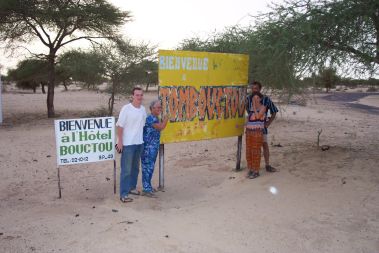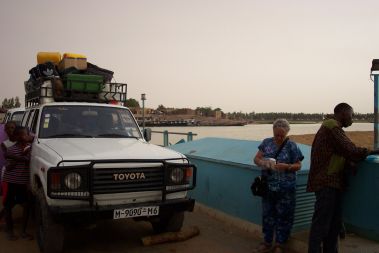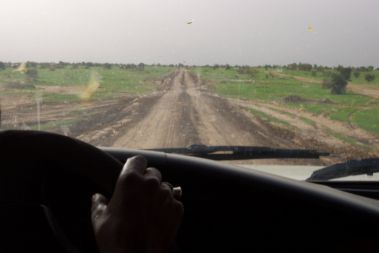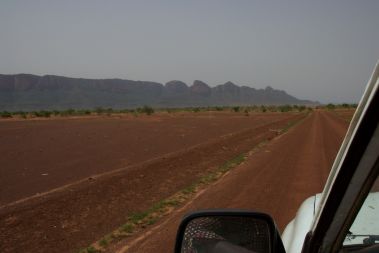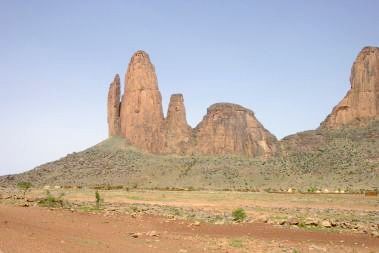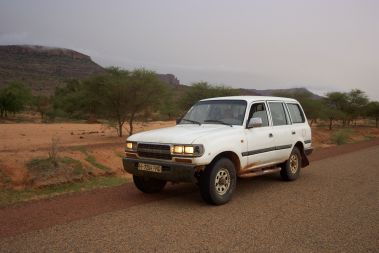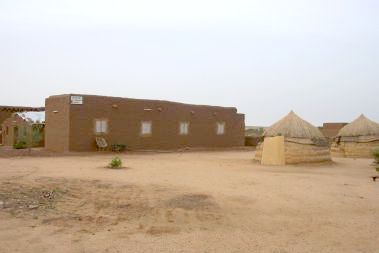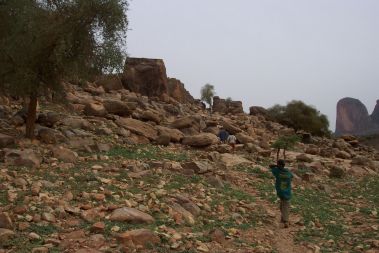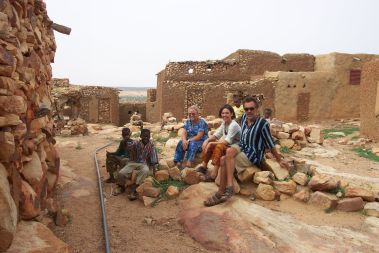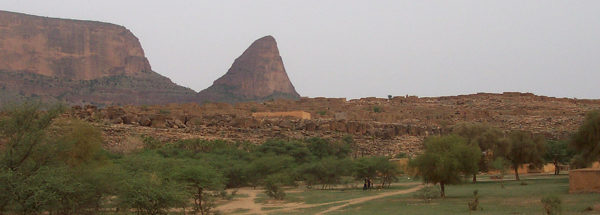Day 16 - Monday, August 2nd, 2004
We needed an early start so getting up at 5:00 the vehicle arrived shortly after I had a shower and packed to get ready. Chris and Sue were already in the vehicle waiting for us (lord knows what time they had been up). The four of us got into the back seat with all of the bags behind. It sounds crowded but actually the vehicle was quite large. It seemed as Ali was going to come with us as he climbed into the back along with our bags.
As we left Timbuktu we got the car to stop at the Timbuktu sign for the obligatory pictures. We have to prove we got there.
Arriving at the ferry “terminal” we were able to get something to drink as well as eat (deep fried dough balls anyone?) though when we finally got onto the ferry Ali had managed to find us some meat with onions and a sauce along with pancake-like bread that we used to pick the meat up with. He put it on the side of the boat so we could help ourselves as the ferry very quickly crossed to the far side of the river.
There was no obvious place for the ferry to dock but it simply ground itself and we just got out. There was no road just a few tracks where vehicles had gone before. For a while we followed the edge of the river until we eventually came to a track that lead away from the river. We were on our way. The track really is just that – places where you keep the tires but not much else around. It was particularly bumpy and uncomfortable for the first little while. The scenery was not terribly interesting with a lot of small trees and shrubs around though we did eventually go through a few swarms of locusts. It was incredible to see the number of insects that we ploughed our way through though, remarkably, only a few got into the car despite our having the windows wide open. They were quite large and bright yellow. A few stuck with us being trapped in the windscreen wipers (though, trying not to be too explicit, parts of them were missing). It was sort of like going through a small snowstorm with big flakes of snow.
There were a few fords we used to cross a few small streams though we did not really see any other “traffic”. I think we passed only one or two vehicles the whole way down to the only village on this road. In this village we left the “road” to drive through the middle of the village (causing a bit of panic with the narrow street and the number of people wandering around) to stop. There was some problem with the vehicle the driver and Ali were looking at (including adding water to the radiator). We wandered down to a bit of a shop (run by someone obviously not originally from Mali) to have some drinks, amazingly, cold despite the lack of any obvious electricity. The town itself, right now, is on the shore of a rather large lake with another rock formation visible on the other side.
Boarding the car again we were past the worse part of the road as we stopped just outside the village at the police checkpoint which was a simple shelter made of plastic just off of the road. We went inside to present our passports and picked up a passenger – someone waiting beside the road for transport – since, doubtless, the number of vehicles going by is quite small. Interestingly, there was a vehicle that had crossed with us on the ferry that has been following us which passed straight through the checkpoint without stopping (much to the consternation of the police officers).
After passing the checkpoint there was more of what we might call a road to follow and the scenery got more interesting as we came up to an escarpment on the left which followed us almost all the way back to the main road at Douentza. There were numerous fords that the driver never seemed to notice until the last minute when he would slam on the brakes and we would careen through the concrete dips in the road. A bit scary sometimes as he really seemed to be in a hurry for some reason.
The main Gao/Bamako road came upon us suddenly as we pulled into Douentza for something to eat. We eventually stopped at a small restaurant (“Restaurant Express”) with a few people selling meat cooking on a grill outside. We got some meat then went into the restaurant to order cold drinks and have a seat. We avoided sitting in the stuffy interior and sat out the back on the “patio” which is right beside what seemed to be a family compound.
The stop was quite quick and we had to have the vehicle push-started before we headed down the road for Hombori. The drive was very interesting as we passed numerous large rock outcrops and escarpments all along the road. The weather made it even more beautiful as the clouds rolled in you could see the tops of the rock mountains in the midst of clouds. We had to stop at one point as the sand came in. Waiting it out we could see we were leaving an area with many rocks then going across a large area of just sand and some small shrugs to our destination which is an obvious clumping of rock formations in the distance: Fatima's Hand and Hombori itself.
Evidently this area is well known (as you might expect) for rock climbing and Hombori is one of these destinations. The town of Hombori is basically all along on either side of the road which, all the way from Douentza has been on the floor of the desert (never going into the rocks themselves), but there is also an older part of the village which is up the side of a pile of rocks a short distance leading to some spectacular views. The desert floor itself is quite boring with a large number of small shrubs and sand. Not much else (occasional very small villages you pass going along the road).
Arriving in Hombori we were told there were no rooms at the first place we stopped but we were directed down the way where we could stay (the six of us) in a simple concrete room with mattresses on the floor. They assured us this was the only place in the village. This was, obviously, not the best solution and we had a bit of a discussion. When we suggested perhaps, since we had rented the car for two days, they could drive us back to Douentza and try to get accommodations there. They assured us that the car was not working very well and they did not want to do that. Pushing a bit harder eventually we visited the “Auberge Le Tendanko” which was a bit off of the main road behind some of the houses. It was completely empty and had very good facilities – clean rooms with beds (with mosquito nets) or grass huts with a single double bed in the middle. The toilets and showers were new and concrete in the corner of the compound with no roof (actually a good idea, keeps them cool – trust me, a GOOD thing). Anne and I took a room (one of the ones with two beds) while Sue & Chris took one hut and Ebrima & Diana took another.
We were a bit upset with the way the driver and Ali were trying to treat us (“no rooms”!) so we agreed it was best just to pay them off and get rid of them – letting us sort things out for transport tomorrow. Later we saw the vehicle parked in the village but later than that we noticed it had left, probably to pick up other clients elsewhere, so much for renting the car for two days!
The Auberge was run by a rather enthusiastic man encouraging us to purchase as much as possible at his hotel but he was quite pleasant enough. Ali had left behind a “friend” who could guide us around Hombori though we did not need one. We eventually did not use him at all.
We ordered our dinner then Sue, Chris, myself and Anne headed off (without Ali's friend) to see Hombori. Walking along the road we met a boy, Ebrima, who offered to show us around the old village (up the hill). We took him up on his offer as he guided us to the place where the children go up and down fetching water in large pails/buckets balanced on their heads (how they don't fall and hurt themselves I don't know – the path is quite steep and tricky). We passed alongside a water pipe leading up to a large holding tank at the top but evidently the pump does not work so the children have to go up with water all the time.
The climb was not that difficult but the view at the top was definitely worth it. The village itself is older with a lot of small houses cobbled together and connected with narrow alleys contained within high walls. We passed by the mosque as well as the tailor (looking through the doorway he was at work on his treadle sewing machine) but passed on a visit to Ebrima's home (we did not want to disturb the family). Many of the alleys passed through buildings so we were in a dark tunnel at some points. It was fascinating and all made out of mud. Many of the people we encountered asked us for drugs – evidently the local hospital has no drugs (they also told us they had no doctors but we learned later they do have a doctor).
We were shown to the far side of the village that had a good view overlooking the lower part of the village where we sat for a few minutes talking to the local children. It was interesting in that one of the children spoke Spanish – Evidently the child of a man who had set up a climbing school here.
The climb down, as could be expected, was not as easy as the climb up and we had to be careful we did not slip (though this happened a few times). We came down behind the market area where we had Ebrima take us to a shop that sold bottled water. Then, as his payment, he was allowed to pick anything in the shop. On our walk he was talking about getting a flashlight/torch (in French, of course) and some batteries but the shop owner seemed to think this was too expensive so eventually Ebrima settled on a small pack that wrapped around him like a belt. We added a few candies from the shop to the deal – He seemed happy with that as we left him to return to the hotel.
Coming back to the hotel we found Diana still waiting for the sandwich she had ordered before we left. We encouraged her and Ebrima to go up to the top to look around. A bit later they did (avoiding the young tour guide they made their own way up along one of the numerous paths).
I wanted to get a picture of the old town from the road so I walked some distance through the town. Along the way I met Ebrima again who wanted to show me somewhere else (I think, my French is not that good) but I declined and continued on. Eventually I got my picture and returned once again to the hotel. You can get to the hotel by crossing diagonally across an abandoned lot that I was amused to watch a mother goat crying for her baby that cried back from across the lot. It was a “Heathcliff…” moment as the two came ever closer with the final coming together a fitting climax. Quite amusing.
Dinner was served quite late and we ate with the aid of a rather bright but small generator-powered light from the hotel. Evidently there is no power in the village so this is what the hotel uses. The food was quite good – for myself, Chris and Anne we had Beef Brochette with sweet potato chips while Sue, Ebrima and Diana had rice with tomato sauce. The fridge they use at the hotel is actually powered by paraffin that we found quite interesting, a lot cheaper than the alternative they use in The Gambia that is gas. Looking at the back of the fridge you could see the flame from the burning paraffin. The comment was made that perhaps this would be a good solution for The Gambia (depending on the availability of paraffin, of course).
The day had not been terribly hot as it stayed overcast most of the day. The room, however, when returned to go to bed, were quite warm so we opened the shutters on the window which continued to slam shut in the wind (we eventually had to prop them open from the outside using a long stick left there for exactly this purpose). I had a cold shower (VERY cold and breezy with no roof).
It is going to be an early evening tonight, we have been busy (again) with a lot of travel and our excursions up the side of the mountain. 9:00, oh dear, really staying up late!
⇒ Continue to Part 5 - The Dogon Valley (Pays Dogon)
In Hombori, Steve stayed at:
- Auberge Le Tendanko
